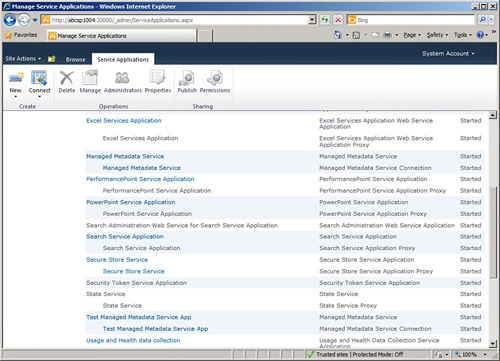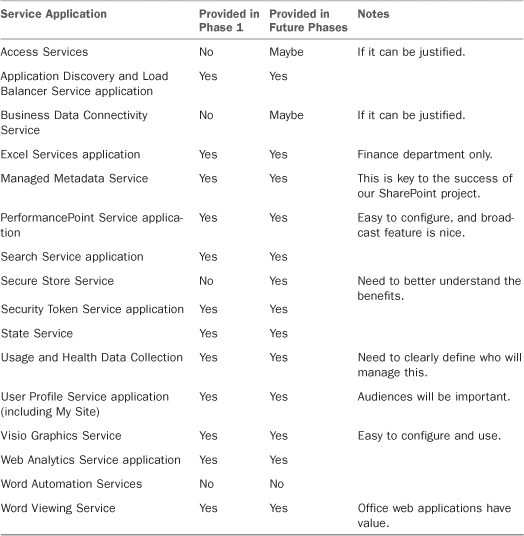Governing the Farm
This section concentrates on the tools provided in the Central Administration site, to provide an overview of the areas the governance plan should include. References are made to other chapters in the book that provide additional detail on specific areas, because each topic can be complex. For the purposes of this chapter, governing the farm can be seen to include the Central Administration site tools and settings combined with PowerShell and stsadm command-line tools and any third-party tools from companies such as AvePoint or Quest that assist the farm administrators with their jobs. The service application tools are embedded in the Central Administration site, and these settings should be clarified in this process.
To begin with, the organization should work through the different components of Central Administration. Chapter 6, “Managing and Administering SharePoint 2010 Infrastructure,” gives a thorough walkthrough of the basic management categories that are broken out in Central Administration, as follows:
• Application Management
• System Settings
• Monitoring
• Backup and Restore
• Security
• Upgrade and Migration
• General Application Settings
• Configuration Wizards
The following is a partial list of important topics for which systemwide policies and standards should be defined:
• Site collection creation standards— Important items to cover in governance include which templates will be used, the use of managed paths, and the creation of different content databases for site collections. In addition, the use of site quotas, and their settings, is included. The site collection administrators need to be defined for each site collection and whether self-service site creation will be allowed.
• “Standard” service application standards— For the required service applications, the settings should be reviewed. For example, the Search Service application has a number of settings that need to be configured, such as Content Sources, Crawl Rules, File Types, Authoritative Pages, Federated Locations, and other settings. The User Profile Storage Service application performs a vital role in synching with Active Directory, and has numerous other capabilities that can be configured, such as compiling audiences. Usage and Health Data Collection is generally considered a vital component for IT to manage and monitor farm usage. Some less-familiar service applications like the Secure Store Service application and Managed Metadata Service application should also be reviewed and tested to see whether and how they will be used in the farm.
• “Optional” service application standards— If SharePoint Server 2010 Enterprise is being used, a number of additional Service applications can be rolled out, including Access Service application, Excel Services Service application, PerformancePoint Service application, PowerPoint Service application, Visio Graphics Service application, and the Word Viewing Service application. The organization needs to decide which of these will be deployed, to which users, and at what point in the project. Rolling out “everything” during the initial phases of a project is generally considered ill-advised unless both the user community and IT are fairly advanced in their SharePoint skills and training is provided for resources who will be managing these tools. Figure 24.4 illustrates the range of service applications available in the Enterprise edition of SharePoint 2010.
Figure 24.4. Service applications in Central Administration.

Note
Chapter 22, “Managing Metadata and Content Types in SharePoint 2010,” provides insight into the power of using managed metadata in SharePoint 2010. Chapter 26, “Extending SharePoint 2010 with Excel Services, Access Services, and Visio Graphics Services,” and Chapter 27, “Office Web Apps Integration with SharePoint 2010,” provide additional information about the configuration options for these service applications. Chapter 30, “Business Intelligence in SharePoint 2010 with PerformancePoint Services,” provides information about and examples of PerformancePoint capabilities.
• Managing services on servers— For multiserver implementations, decisions should be made concerning which services will run on which server. This can impact performance and the user experience, since overloading servers will impact their responsiveness.
• Monitoring settings— Special attention should be given to the tools in this section of the Central Administration site as they allow the farm administrators to review problems and solutions, review rule definitions, review job definitions and job status, view administrative reports, configure diagnostic logging, review information management policy usage reports, view health reports, configure usage and health data collection, and view web analytics reports. Chapter 11, “Monitoring a SharePoint 2010 Environment,” provides more information about these built-in tools and provides information about Microsoft’s System Center Operations Manager (SCOM) 2007 R2.
• Backup and Restore— A high-level decision to be made here is whether the native SharePoint backup and restore tools will be used or if third-party backup tools from Symantec, Commvault, AvePoint, or others will be used. If the native SharePoint tools will be used, the farm administrators need to become familiar with the use of these tools and understand their strengths and weaknesses. Although a basic service level agreement (SLA) may be separate from the governance plan, the capabilities of the tools will affect the farm administrators’ ability to meet end-user requests. Chapter 10, “Backing Up and Restoring a SharePoint Environment,” provides additional information about this topic, including using PowerShell for backup and restore, and backing up IIS 7 configurations.
• Security— This page provides access to tools such as the farm administrators group and its members, web application security policies, managed accounts, service accounts, blocked file types, web part security, information rights management, and whether labels, barcodes, auditing, and retention will be available for use. Chapter 15, “Implementing and Validating SharePoint Security,” gives additional information about this topic.
• General Application Settings— As shown in Figure 24.5, these settings include tools such as External Service Connections, InfoPath Forms Services, Site Directory, SharePoint Designer, Search, Reporting Services, and Content Deployment. Each of these tools should be reviewed and decisions made about their configurations.
Figure 24.5. General Application Settings page in Central Administration.

Having reviewed this list, it may sound like an overwhelming task to define how each and every component will be configured. However, it might be sufficient, based on the organizational needs, to just create a grid of which features and tools will be made available during the initial phase and not delve too deeply into the individual configurations of the tools.
Chapter 18, “SharePoint Foundation Versus SharePoint Server 2010,” provides a number of charts that can easily be adapted for use in the governance plan, to provide a summary of high-level organizational decisions about which tools and features will be used and supported. For example, Table 24.1 provides a sample grid that could be used to define the decisions that are made in the area of service applications with a minimal investment of time, and without delving too deeply into the details of the configuration of each service application.
Table 24.1. Governance Plan for Service Applications for Company ABC

Tip
A recommended best practice for the development of governance documentation is to have a lab environment available where team members can gain experience with the Enterprise version of SharePoint 2010, where all service applications are enabled and configured. This can also be used when reviewing the site collection and site features that will be supported and also the list and library features and tools.
As mentioned previously, other chapters in this book review features at this level and can help designers and planners determine which features offer the most value to the organization and should therefore be governed.
For some organizations, the activity of reviewing the functionality can be done in the scope of a few hours; in others, this process may take months. In either case, the end result is a list of functionality that helps give shape to the governance plan in terms of which tools and features will be supported by IT and therefore need to be governed.
Another key element of the governance plan is defining the scope for which functionality will be governed. Whereas some settings are global to the farm, others are specific to the web application or the service application, and therefore can be made available to limited groups of users. This can, of course, complicate the governance process, but in most organizations, there is a demographic of users who are highly advanced and can be trusted to use more advanced functions, whereas a majority of users would simply get confused or not be interested. Being able to cater to the more advanced group is often where innovation and improvements come from. For additional granularity, features can be activated/deactivated at the site, site collection, web application, or farm level. Depending on how your organization decides to develop its taxonomy or information architecture, activate the features at the appropriate scope to simplify management. The web application and site collection level are typically a better place to manage most functions.
